Das Problem „Fehler zu viele Weiterleitungen“ ist ein WordPress-Fehler, der durch ein Plugin oder falsche Einstellungen verursacht werden kann. In der Tat ist dies einer der häufigsten Fehler, die unsere Besucher und andere Benutzer von WordPress sehen.
Dieser Fehler kann sogar dazu führen, dass Sie nicht mehr auf Ihre Website zugreifen können, was die Behebung des Problems etwas schwierig macht. Glücklicherweise haben wir die Problembehandlung des Problems der zu vielen Weiterleitungen schon mehrfach durchgeführt, sodass wir genau wissen, was zu tun ist.
In diesem Artikel zeigen wir Ihnen, wie Sie das Problem „Fehler zu viele Weiterleitungen“ in WordPress leicht beheben können. Wir zeigen Ihnen auch, wie Sie den Zugriff auf Ihre Website wiederherstellen und den Fehler beheben können.

Experten-Tipp: Möchten Sie die Problembehandlung lieber den Profis überlassen? Unsere WordPress-Supportdienste beheben Ihre Fehler im Handumdrehen und bringen Ihre Website wieder zum Laufen. Außerdem bieten wir einmalige Fehlerbehebungen an, sodass Sie sich keine Gedanken über laufende Verträge machen müssen.
Was ist die Ursache für den Fehler „Zu viele Weiterleitungen“ in WordPress?
Der Fehler „Zu viele Weiterleitungen“ wird durch eine falsch konfigurierte Weiterleitung in WordPress verursacht.
Wie Sie vielleicht bereits wissen, verfügt WordPress über eine SEO-freundliche URL-Struktur, die die Weiterleitungsfunktion nutzt. Auch viele beliebte WordPress-Plugins nutzen diese Funktion, um temporäre Weiterleitungen einzurichten, permanente 301-Weiterleitungen zu erstellen und 404-Fehler zu beheben.
Wenn Sie ein Plugin verwenden, um das Problem der unsicheren SSL-Inhalte zu beheben, oder ein WordPress-Caching-Plugin, dann kann dies auch Weiterleitungen beeinflussen und den Fehler „zu viele Weiterleitungen“ verursachen.
So sieht die Meldung „ERR_TOO_MANY_REDIRECTS“ in Google Chrome aus.
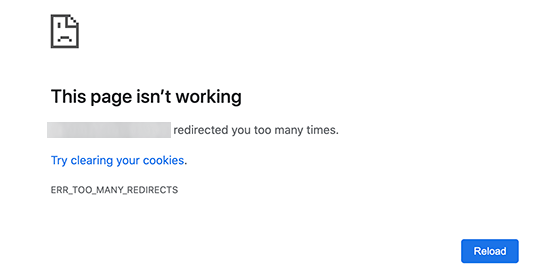
Dieser Fehler sagt Ihnen jedoch nicht, was den Konflikt verursacht und die Umleitungsschleife in WordPress erzwingt.
So sieht der Fehler in Firefox aus, mit der Meldung „Die Seite wird nicht richtig weitergeleitet“.
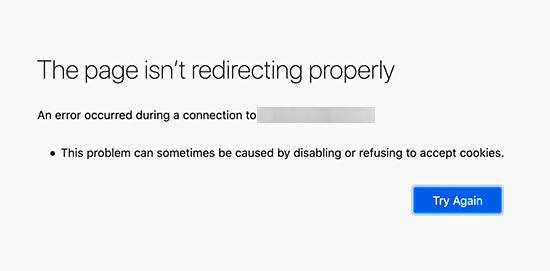
Schauen wir uns also an, wie man den Fehler „zu viele Weiterleitungen“ in WordPress beheben kann.
Wir führen Sie Schritt für Schritt durch die Fehlersuche, verschaffen Ihnen Zugang zu Ihrer WordPress-Website und verhindern, dass der Fehler erneut auftritt.
Video-Anleitung
Wenn Sie eine schriftliche Anleitung bevorzugen, dann lesen Sie einfach weiter.
1. Browser-Cookies und Cache löschen
Eine häufige Ursache für den Fehler könnten die Cookies Ihres Webbrowsers sein. Versuchen Sie, Ihre Website mit einem anderen Webbrowser wie Firefox, Safari, Opera oder Microsoft Edge aufzurufen.
Wenn Sie mit einem anderen Browser normal auf Ihre Website zugreifen können, müssen Sie die Cookies und den Cache in Ihrem normalen Browser löschen.
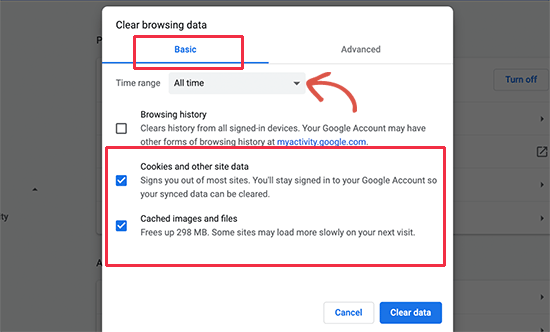
Wir haben eine detaillierte Anleitung, wie Sie Ihren Browser-Cache in allen gängigen Browsern leeren können, die Ihnen dabei helfen wird.
Wenn der Wechsel des Browsers das Problem jedoch nicht behebt, können Sie zum nächsten Schritt übergehen.
2. Deaktivieren Sie alle WordPress-Plugins
Die häufigste Ursache für WordPress-Weiterleitungsschleifen oder „ERR_TOO_MANY_REDIRECTS“ ist ein Plugin-Konflikt. Ein WordPress-Plugin, das versucht, eine Weiterleitung in einer Weise einzurichten, die mit den Standard-WordPress-Weiterleitungen in Konflikt steht, kann diese Fehlermeldung verursachen.
Um dies zu beheben, müssen Sie alle WordPress-Plugins auf Ihrer Website deaktivieren. Normalerweise können Sie einfach auf die Seite Plugins “ Alle Plugins im WordPress-Administrationsbereich gehen und Plugins von dort aus deaktivieren.
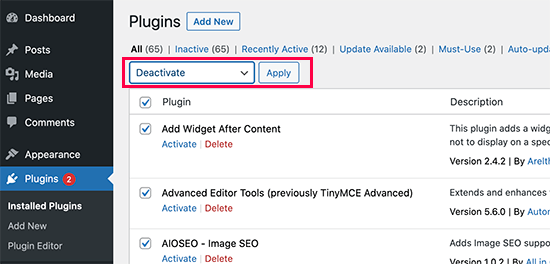
Wir gehen jedoch davon aus, dass Sie aufgrund des Redirect-Fehlers nicht auf den WordPress-Adminbereich zugreifen können.
In diesem Fall müssen Sie die WordPress-Plugins mit einem FTP-Client wie FileZilla oder der Dateimanager-App in Ihrem WordPress-Hosting-Kontrollpanel deaktivieren.
Verbinden Sie sich einfach mit einem FTP-Client mit Ihrer Website und gehen Sie zum Ordner /wp-content/.
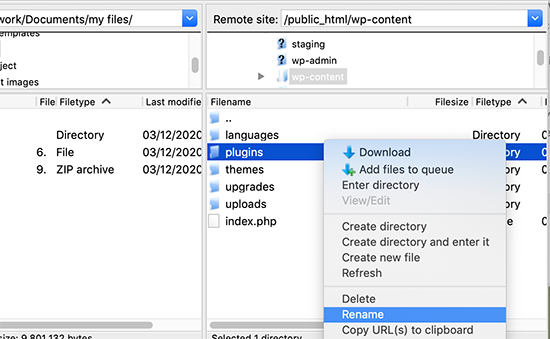
Dort finden Sie den Ordner “ plugins", den Sie in „plugins.deactivate“ umbenennen müssen.
Auf diese Weise werden alle WordPress-Plugins auf Ihrer Website deaktiviert.
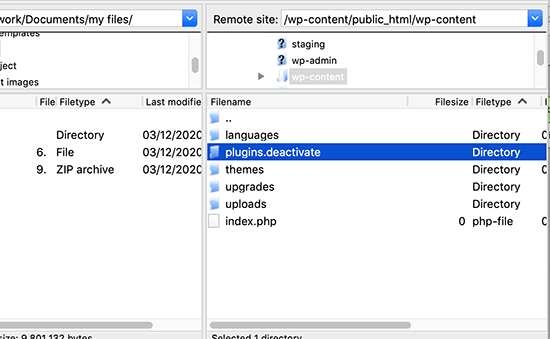
Grundsätzlich sucht WordPress nach einem Ordner namens plugins, um die Plugin-Dateien zu laden. Wenn es den Ordner nicht findet, deaktiviert es automatisch die aktiven Plugins in der Datenbank.
Jetzt können Sie versuchen, Ihre WordPress-Website zu besuchen. Wenn Sie sich jetzt in Ihren WordPress-Administrationsbereich einloggen können, bedeutet dies, dass eines der Plugins den Fehler verursacht hat.
Um herauszufinden, welches Plugin der Übeltäter war, müssen Sie zurück zum FTP-Client oder zur Dateimanager-App wechseln und den Ordner plugins.deactivate wieder in „plugins“ umbenennen.
Wechseln Sie danach in den WordPress-Verwaltungsbereich Ihrer Website und gehen Sie auf die Seite Plugins “ Alle Plugins. Von hier aus können Sie Ihre Plugins eines nach dem anderen aktivieren und dann Ihre Website besuchen, um zu sehen, ob Sie den Fehler reproduzieren können.
Sobald Sie das Plugin gefunden haben, das den Fehler verursacht, können Sie eine Alternative zu diesem Plugin finden oder das Problem im WordPress-Supportforum des Plugins melden.
3. WordPress-URLs korrigieren
Eine weitere Hauptursache für diesen Fehler ist eine Fehlkonfiguration in den WordPress-URL-Einstellungen. Normalerweise können Sie diese Optionen auf der Seite Einstellungen “ Allgemein einsehen.
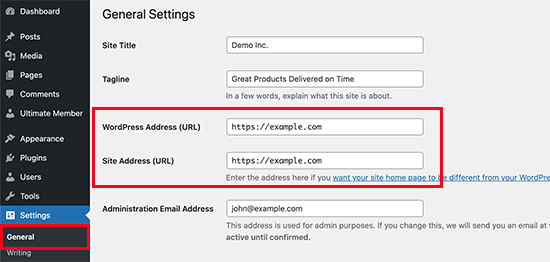
Bei den meisten Websites müssen die URLs in den Feldern „WordPress-Adresse“ und „Website-Adresse“ identisch sein. Manche Benutzer verwenden jedoch in einer URL „www“ und in der anderen eine Nicht-WWW-URL.
Da Sie möglicherweise keinen Zugriff auf den WordPress-Verwaltungsbereich haben, müssen Sie die WordPress-URLs mit einem FTP-Client oder der Dateimanager-App korrigieren.
Verbinden Sie sich einfach mit einem FTP-Client mit Ihrer WordPress-Website und gehen Sie zu /wp-content/themes/ihr-theme-ordner/.

Von hier aus müssen Sie die Datei functions.php finden und sie mit einem einfachen Texteditor wie Notepad oder TextEdit bearbeiten.
Als Nächstes müssen Sie den folgenden Code am Ende hinzufügen:
update_option( 'siteurl', 'https://example.com' );
update_option( 'home', 'https://example.com' );
Vergessen Sie nicht, „https://example.com“ durch die URLs Ihrer eigenen Website zu ersetzen. Sie können nun Ihre Änderungen speichern und die Datei wieder auf Ihre Website hochladen.
Versuchen Sie danach, Ihre Website zu besuchen, um zu sehen, ob der Fehler dadurch behoben wird.
Weitere Methoden finden Sie in unserem Tutorial, wie Sie WordPress-URLs einfach ändern können.
4. WordPress .htaccess-Datei zurücksetzen
Die .htaccess-Datei ist eine spezielle Datei, die vom Website-Server zur Verwaltung von Weiterleitungen und anderen Servereinstellungen verwendet wird. WordPress verwendet diese Datei auch für SEO-freundliche URLs und andere Weiterleitungen.
Manchmal können WordPress-Plugins Änderungen an der .htaccess-Datei Ihrer Website vornehmen, die diesen Fehler auslösen können. Es ist auch möglich, dass das Deaktivieren eines Plugins diese Änderungen nicht aus Ihrer .htaccess-Datei entfernt.
In diesem Fall müssen Sie Ihre WordPress-.htaccess-Datei manuell zurücksetzen.
Auch hier müssen Sie mit einem FTP-Client oder der Dateimanager-App in Ihrem Hosting-Dashboard auf Ihre Website zugreifen. Sobald Sie verbunden sind, sehen Sie die .htaccess-Datei im Stammverzeichnis Ihrer Website.
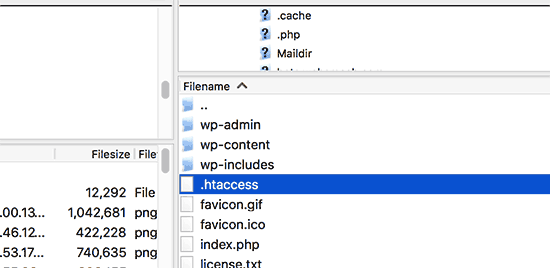
Hinweis: Wenn Sie Ihre .htaccess-Datei nicht finden können, lesen Sie unsere Anleitung, wie Sie die .htaccess-Datei in WordPress finden.
Zunächst müssen Sie eine Kopie Ihrer .htaccess-Datei auf Ihren Computer herunterladen, um sie zu sichern. Danach können Sie die Datei von Ihrer Website löschen.
Sie können nun versuchen, Ihr WordPress-Blog zu besuchen. Wenn alles normal funktioniert, bedeutet dies, dass Ihre .htaccess-Datei den Umleitungsfehler verursacht hat.
Da wir die .htaccess-Datei gelöscht haben, müssen Sie sie jetzt neu erstellen. Normalerweise kann Ihre WordPress-Website dies selbst tun. Um sicherzugehen, gehen Sie einfach auf die Seite Einstellungen “ Permalinks und klicken Sie auf die Schaltfläche „Änderungen speichern“ am unteren Rand.
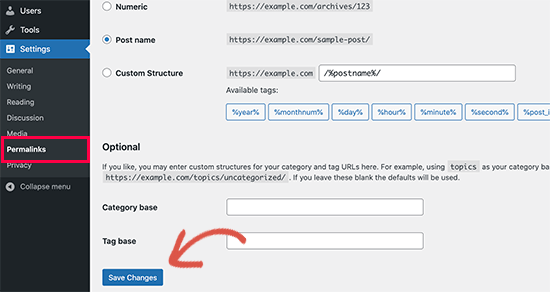
5. Fehlervermeidung bei zu vielen Weiterleitungen in WordPress
Hoffentlich haben die soeben beschriebenen Schritte das Problem der Weiterleitung auf Ihrer Website behoben. Wenn sie das Problem nicht behoben haben, müssen Sie möglicherweise mit Ihrem WordPress-Hosting-Unternehmen sprechen, um sicherzustellen, dass es kein Serverproblem gibt.
Sobald das Problem auf Ihrer Website behoben ist, sollten Sie auch in der Lage sein herauszufinden, was die Ursache ist.
Wenn es ein Plugin war, müssen Sie das Problem im Support-Forum des Plugins melden. Siehe unseren Leitfaden, wie Sie WordPress-Support anfordern. Wenn Sie jedoch keine Hilfe bekommen können, können Sie immer ein alternatives Plugin finden, das dasselbe tut.
Wenn der Fehler durch eine Fehlkonfiguration der WordPress-Site verursacht wurde, können Sie sich dies notieren und sicherstellen, dass Ihre Site-Einstellungen richtig eingerichtet sind.
Weitere Tipps finden Sie in unserer ausführlichen Anleitung zur Fehlerbehebung bei WordPress-Problemen, die Sie selbst durchführen können.
Wir hoffen, dass dieser Artikel Ihnen geholfen hat, das Problem „Fehler zu viele Weiterleitungen“ auf Ihrer Website zu lösen. Vielleicht möchten Sie auch ein Lesezeichen für unser ultimatives Handbuch der häufigsten WordPress-Fehler setzen und sehen , wie Sie den WordPress-Support kontaktieren können.
Wenn Ihnen dieser Artikel gefallen hat, dann abonnieren Sie bitte unseren YouTube-Kanal für WordPress-Videotutorials. Sie können uns auch auf Twitter und Facebook finden.





Syed Balkhi says
Hey WPBeginner readers,
Did you know you can win exciting prizes by commenting on WPBeginner?
Every month, our top blog commenters will win HUGE rewards, including premium WordPress plugin licenses and cash prizes.
You can get more details about the contest from here.
Start sharing your thoughts below to stand a chance to win!
Kamal says
I tried all the solutions given above, still getting the same error „redirected you too many times.“.
It will be really helpful if I can get any SPOC from WordPress or any other solution which can be tried.
WPBeginner Support says
If none of the methods from our article were able to solve the issue, we would recommend reaching out to your hosting provider to ensure nothing from their end could be the cause of the error and they should be able to help find the reason for the problem.
Admin
Kerri-Anne says
If you’re using CloudFlare or something like that, especially with GoDaddy, that often causes a redirect loop as well. Update the DNS / Nameservers.
WPBeginner Support says
Thank you for sharing what solved it for you!
Admin
Kingsley Chukwuemeka says
In my case, the issue affects only some blog posts and I am wondering if this same process will work.
WPBeginner Support says
It should still work even if it is only a few posts.
Admin
Valerie says
Thank you, 3. Fix WordPress URLs – this one helped!
WPBeginner Support says
Happy to hear our recommendation helped!
Admin
Nata says
Thank you! Removing the plugin that caused the conflict helped.
WPBeginner Support says
Glad our recommendations were helpful!
Admin
Mike says
Thank you! Nothing was working for me, changing this SSL setting helped!
WPBeginner Support says
Glad our guide could help!
Admin
Andrew says
Thank you so much, deleting the ht.access file worked for me
WPBeginner Support says
Glad our guide could help
Admin
Alex Froitzheim says
Thanks so much for the article! In my case, the problem turned out to be a different one: My domain contained an umlaut (ü). I had to convert my domain name to Punycode and change my wordpress address and site address to the resulting URL.
WPBeginner Support says
Thanks for sharing this for anyone who may also have this issue with an umlaut!
Admin
Brad Vickers says
If none of the above works and you are using Cloudflare for DNS, check your SSL settings in Cloudflare. If you have an SSL installed on your hosting server, you need to change the SSL mode to Full (strict) in Cloudflare.
WPBeginner Support says
Thanks for sharing what worked for you for this issue.
Admin
Jonathan Engelsma says
This Cloudflare setting seems to have been my prob… after days of digging around. Thanks man!
Chethan Kumar says
Thank you so much, it helped me a lot… My WP site is struck at page loading, i deleted .htaccess file from server after this working fine… you saved my time… loved it
Gimhan says
Thanks a lot for the content. Removing the .htaccess file which I created manually and letting WordPress create the .htaccess file automatically resolved my issue.
Thanks again.
Mark Lidster says
Man, you just saved me a whole heap of time as I’d created a url redirect from within the admin panel then couldn’t obviously get back in. Thought I was going to have to restore an old backup and lose all my work, but your simple addition to the config file via ftp saved all of that. Thank you so much
WPBeginner Support says
Glad our guide was helpful
Admin
Stephen says
Hi,
I tried to add the www. in general settings in wordpress as you suggested, only now i cannot acces my wordpress domain anymore… it says it does not recognize my login username and/or password, any suggestions?
WPBeginner Support says
You can check your username and password using our guide below:
https://www.wpbeginner.com/beginners-guide/how-to-change-your-password-in-wordpress/
Admin
Solomon says
Good day,
I have tried all these and nothing seems to be working.
WPBeginner Support says
If none of these recommendations are working for you, we would recommend reaching out to your hosting provider for assistance
Admin
Jay Wulf says
Hi, I was struggling with this issue for a while and it took me a great degree of research to actually find the solution.
If you are experiencing „Too many redirects“ problem with WordPress
In my situation, the new website was behind a reverse proxy (NGINX).
You need to add this to the fix list above.
Modify wp-config.php add the text
/**
* Handle SSL reverse proxy
*/
if ($_SERVER[‚HTTP_X_FORWARDED_PROTO‘] == ‚https‘)
$_SERVER[‚HTTPS‘]=’on‘;
if (isset($_SERVER[‚HTTP_X_FORWARDED_HOST‘])) {
$_SERVER[‚HTTP_HOST‘] = $_SERVER[‚HTTP_X_FORWARDED_HOST‘];}
WPBeginner Support says
Thank you for sharing for those on NGINX servers
Admin
Antoine says
It solved my problem!
I was on HTTPS behind an nginx proxy and I had a redirect loop. Editing the wp-config did the trick!
Ian says
Thank you so much, this fixed my problem on AWS (using Apache)
nechry says
It also solve my redirect problem!
thank-you
Dhruv says
Hello, my problem is not getting solved. My homepage is working fine but the wp-admin has this redirect problem
WPBeginner Support says
You would want to go through some of our recommendations in our article below:
https://www.wpbeginner.com/beginners-guide/beginners-guide-to-troubleshooting-wordpress-errors-step-by-step/
To help find the issue
Admin
Jack Mwangi says
I cannot be able to express my gratitude but I realy thank you very much for your assistance. The last method really worked for me.. Thanks a lot again.
WPBeginner Support says
You’re welcome, glad our guide was helpful
Admin
Jim Biancolo says
There’s a fix in the WP is_ssl() docs that worked for me
Mohammed Alshami says
at my site i did all the mentioned steps and i still don’t get any thing i don’t know how to fix it anyone can help ?
WPBeginner Support says
If none of our recommendations were able to assist, we would recommend reaching out to your hosting provider for them to take a look.
Admin
Jasmin Jai says
Wonderful content and very informative! It took awhile but we were able to fix our WordPress issue online on our website because of your helpful article here! Thanks again.
WPBeginner Support says
Glad our guide was helpful
Admin
Jim Biancolo says
I was tearing my hair out over this and found another thing to check. If you’re behind a load balancer this can cause the WordPress is_ssl() function to return incorrect values, which can put you into a redirect loop as it tries to redirect to a secure URL even though you’re already at a secure URL.
Mohammed Alshami says
how did you fix it ?
Aylin says
Hello. I have tried every recommendation that you have given: plugin, htaccess, wp-config.php but none of them works for me. Please help!!! Thanks
WPBeginner Support says
If none of these recommendations were able to help you, then we would recommend reaching out to your hosting provider for them to take a look
Admin
Reginald says
Thank you for this article. Very informative and the way you explained things was so helpful.
I understand the issue when it is happening over the entire website. My problem is that one category of pages (registration pages for my memberships) is being affected by this issue. Any idea why the error would be specific to a category?
Every other page on my site is working.
WPBeginner Support says
You would first want to go through the steps in this article. If it still continues you would want to ensure you don’t have any plugins possibly creating redirects.
Admin
Joseph says
Hi, Please what should i do?
i followed the steps involved in removing the /wp in my siteurl. then immediately i altered the wordpress and siteurl and saved changes, i have been unable to login into the wp-admin. the following is the error message i received.
„The document has moved here.
Additionally, a 302 Found error was encountered while trying to use an ErrorDocument to handle the request.“
thank you
WPBeginner Support says
It would depend on which of the methods you used from our article below for removing WordPress from your URL:
https://www.wpbeginner.com/wp-tutorials/how-to-get-rid-of-wordpress-from-your-wordpress-site-url/
Admin
Solomon Daniels says
Hi! I cloned my site to a new URL using GoDaddy’s Installatron feature, and now when I try to access the cloned site using the new URL, it says ‚too many redirects.‘ This means I can’t even access the WordPress back end. Is there a way to try disabling plugins without that access? Do I just temporarily move them to a new folder? Or do you have any suggestions?
WPBeginner Support says
We have a guide for how to disable plugins that you can follow here:
https://www.wpbeginner.com/plugins/how-to-deactivate-all-plugins-when-not-able-to-access-wp-admin/
Admin
Oksana says
May God bless you, the author of this article!!!!
WPBeginner Support says
Glad our article was helpful
Admin
U.A says
Thanks a lot, solved a big issue for me here!
WPBeginner Support says
You’re welcome, glad our article was helpful
Admin
ABDUL says
That’s Why I Love wpbeginner, only one minute to solve. Thanx Syed balkhi sir And Team.
WPBeginner Support says
Glad our guide was able to help you
Admin
Gofar ahmad says
Thanks for all. I love wpbeginner. the best content.
WPBeginner Support says
You’re welcome, glad you like our content
Admin
Mal says
How did you know my service provider wouldnt take any blame….its like you new there feed back exactly
Thanks for saving the day
WPBeginner Support says
You’re welcome, glad our article could help you solve the issue
Admin
Ben Jamir says
Beautiful…so nicely explained..this solved my problem
Thank you for such a detailed post.
WPBeginner Support says
You’re welcome, glad you found our post helpful
Admin
Daniel Cervantes says
Well, our website was working just fine then all of a sudden our site went down,
I did all the steps above.
what else can we do?
WPBeginner Support says
If the methods in this article aren’t working and you’re seeing the too many redirects error, you would want to reach out to your hosting provider to ensure this isn’t an error from their end.
Admin
Teja T. Diay says
I tried with deleting the www. and now I can’t even log in in to the wp-admin anymore, I just get a page with info saying that my page is not working due to too many redirects.
How can I fix this, I need to continue developing my website.
„This page isn’t working redirected you too many times.
Try clearing your cookies.
ERR_TOO_MANY_REDIRECTS“
WPBeginner Support says
You would want to bring back the www to your site, to do that you would edit the options table similar to our guide here:
https://www.wpbeginner.com/beginners-guide/how-to-reset-a-wordpress-password-from-phpmyadmin/
Once you do, for removing www you can follow our guide here:
https://www.wpbeginner.com/beginners-guide/www-vs-non-www-which-is-better-for-wordpress-seo/
Admin
Randy King says
Here is a totally bizarre solution. The infinite login loop just started happening with no change in plugins, etc. I did everything – changed my theme, replaced the .htaccess file, etc. Here’s what I finally ended up doing that seems to have fixed everything: I rebooted my laptop and waited for several hours (in case it was a hosting problem). When I came back in, it all worked.
I tried clearing browser cache and did everything I could find, but nothing worked. I suspect there was something wacky going on that a reboot cleared up for me. And this is not the first time that this happened. Totally bizarre.
WPBeginner Support says
That is an odd solution but thanks for sharing it, you may want to check with your hosting provider to see if they see the error as well if it continues.
Admin
SG says
I’m facing a problem with my multisite network. Its created in local host. Everytime I try to access the new site it shows an error saying „The page isn’t redirecting properly“. If you can help that’d be great! Thanks
WPBeginner Support says
You would want to start with the steps in this article to see if that resolves the issue
Admin
nasirey says
i have problem for accessing my wordpress dashboard, when i try to access my wp- admin area it shows me your password is incorrect although my password is correct so if any one can help that kind of problem reply me. thanks.
WPBeginner Support says
You could try force resetting your password using: https://www.wpbeginner.com/beginners-guide/how-to-reset-a-wordpress-password-from-phpmyadmin/
Admin
aleecode says
awesome, it works. thanks
WPBeginner Support says
Glad our recommendation could help
Admin
Lisa says
Thanks for the article. I was able to fix my „too many redirects“ problem by changing the http to https.
WPBeginner Support says
Thanks for sharing the solution that worked for you
Admin
David Najman says
Hi,
I had this error on the product tag page. I tried all the possible repairs mantioned above with no luck.
Finally, I had to rename slug for tags not to be numbers, eg. 2016, so I renamed it to r2016 and it started to work!
It must have been caused by some wordpress update, because it have been working few years before with tags named as numbers.
WPBeginner Support says
Thanks for sharing what worked for you, if your product page is created by a plugin you may want to try reaching out to the plugin’s support to let them know about that issue
Admin
Yavan Kumar says
Hi,
My whole website is running properly, but the homepage is redirected too many times and same issue with the wp-admin page too. I tried all the methods you mentioned but nothing worked for me.
Please advice me if there is any another solution for that.
Thanks in advance…
WPBeginner Support says
If none of the methods from the article worked, you would want to reach out to your hosting provider for them to see if there are any issues they can see on their end.
Admin
John Zoetebier says
My web site is a Bitnami WordPress deployment on Google Cloud Platform.
When I use:
define(‚WP_SITEURL‘, ‚http:/example.cloud‘);
the home page gets redirected to itself and browsers error message.
I now use the original Bitnami setting and it works great !
define(‚WP_SITEURL‘, ‚http://‘ . $_SERVER[‚HTTP_HOST‘] . ‚/‘);
WPBeginner Support says
You are missing a slash next to your http in the first define statement but thank you for sharing your workaround.
Admin
Chad says
I had to desactivate a plugin and it worked back fine. I identified the plugin to desactivate by looking into my URL where I was getting a redirect error. The plugin name was written there.
WPBeginner Support says
Thanks for sharing how you found the error for others trying to solve this problem
Admin
Nirav Patel says
Thanks you bro for information of wp error
WPBeginner Support says
Glad our article could help
Admin
irga says
yeah, you know,,, i searching for it,,,,, and then mys wordpress site working again, thanksfull
Rahul says
Thans buddy , really helps
Josh says
I’ve tried all the steps here with no luck today. Luckily my website is functioning ok but I can’t log into the wp-admin dashboard for anything.
What are the other options? There must be other ways I can figure out what’s causing it?
Deby says
I’m having the same. My site works fine for visitors, but I only get the redirect error for the backend, my WP dashboard.
It’s a new site and I don’t even have any plugins installed yet. I’m stumped.
Bryant Thomas says
Holy Cow That worked, I’ve done many websites migrations and never ran into this issue. Thank you the define(‚WP_HOME‘,’http://example.com‘);
define(‚WP_SITEURL‘,’http://example.com‘); worked with the www.
Rutvi Trivedi says
Hi, My problem is when I go to my site’s dashboard(/wp-admin) it is giving me this error I tried this solution and unfortunately it is not working. Please help me to solve this error.
Shakeane says
I just want to say thank you so much for sharing this knowledge, you wouldn’t understand how much this has helped me, something as minor is adding www or leaving the forward slash at the end has caused so many headaches, thank you so much.
Marc says
Awesome! Only took 5 minutes and fixed!!!